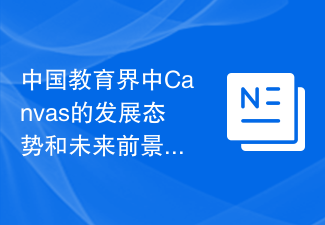 Web Front-end
Web Front-end CSS Tutorial
CSS Tutorial Ajax technology: the development and evolution of tradition and modernity
Ajax technology: the development and evolution of tradition and modernity
From tradition to modernity: the development and evolution of Ajax technology
Introduction:
With the development of the Internet, web design and development are also constantly evolving. Traditional web pages transmit and display data through page refresh between the user and the server. This method has many inconveniences and efficiency problems. The emergence of Ajax (Asynchronous JavaScript and XML) technology has completely changed the way traditional web pages work, providing a faster and more efficient interactive experience. This article will explore the development and evolution of Ajax technology from tradition to modernity, while providing specific code examples.
1. Limitations of traditional web pages
In traditional web design, the interaction between the user and the server is mainly achieved through page refresh. When the user needs to submit form data or request server data, the web page will be reloaded, which leads to an unsmooth user experience and low efficiency. In addition, when traditional web pages process large amounts of data, they will generate a lot of network traffic and server pressure.
2. Introduction to Ajax technology
Ajax technology realizes real-time asynchronous data interaction and user interface updates without page refresh by utilizing JavaScript, XMLHttpRequest and back-end services. The core idea is to split a web page into multiple independent components, each component is responsible for handling specific data requests and updates. Through asynchronous requests, Ajax technology allows web pages to interact with the server in the background and dynamically update the acquired data.
3. Advantages and applicable scenarios of Ajax
- Reduce the amount of data transmission: Since Ajax only needs to transmit data without reloading the entire page, it can greatly reduce the amount of data transmitted on the server side. The amount of data in requests and responses to and from the client.
- Improve user experience: Through refresh-free updates, Ajax makes the data display in the user interface faster and smoother.
- Support multiple data formats: Ajax is not limited to XML format, but can also support the transmission of multiple data formats such as JSON, HTML, and Text.
- Improve web page performance: By reducing server requests and reducing the number of page refreshes, Ajax can greatly improve the loading speed and performance of web pages.
- Real-time data update: Ajax technology allows web pages to interact with the server in real-time to realize the display and update of real-time data.
4. Development and evolution of Ajax technology
- Original Ajax implementation
The earliest Ajax used the XMLHttpRequest object for asynchronous request and transmission of data. The following is a simple sample code:
var xmlhttp=new XMLHttpRequest();
xmlhttp.open("GET","example.php",true);
xmlhttp.onreadystatechange=function(){
if(xmlhttp.readyState==4 && xmlhttp.status==200){
document.getElementById("result").innerHTML=xmlhttp.responseText;
}
}
xmlhttp.send();- jQuery's Ajax encapsulation
In order to better handle Ajax requests, jQuery and other front-end frameworks encapsulate Ajax methods, simplifying code operations. Provides richer asynchronous request processing and error handling options. The following is a sample code using jQuery's Ajax method:
$.ajax({
url: "example.php",
method: "GET",
success: function(response){
$("#result").html(response);
},
error: function(xhr, status, error) {
console.log(xhr.responseText);
}
});- The emergence of Fetch API
Fetch API is a new Web API that provides a simpler and more powerful way to handle Ajax requests. It uses Promise objects to handle asynchronous requests and responses, and can use async/await syntax to handle asynchronous code. The following is a sample code using the Fetch API:
fetch('example.php')
.then(response => response.text())
.then(data => {
document.getElementById("result").innerHTML = data;
})
.catch(error => {
console.log(error);
});5. Conclusion
From tradition to modernity, the development and evolution of Ajax technology has brought huge changes to Web development. Through asynchronous requests and partial refresh, Ajax technology provides a smoother and more efficient interactive experience, and reduces network overhead and server load. The traditional XMLHttpRequest was replaced by the more convenient jQuery Ajax method, and the emerging Fetch API is even better in simplicity and functionality. With the continuous development of technology, people's demand for Ajax technology will become higher and higher. Whether we are developing web pages, mobile applications or single-page applications, Ajax technology can provide us with a better user experience and more efficient data interaction.
The above is the detailed content of Ajax technology: the development and evolution of tradition and modernity. For more information, please follow other related articles on the PHP Chinese website!
 什么是ajax重构Jul 01, 2022 pm 05:12 PM
什么是ajax重构Jul 01, 2022 pm 05:12 PMajax重构指的是在不改变软件现有功能的基础上,通过调整程序代码改善软件的质量、性能,使其程序的设计模式和架构更合理,提高软件的扩展性和维护性;Ajax的实现主要依赖于XMLHttpRequest对象,由于该对象的实例在处理事件完成后就会被销毁,所以在需要调用它的时候就要重新构建。
 jquery ajax报错403怎么办Nov 30, 2022 am 10:09 AM
jquery ajax报错403怎么办Nov 30, 2022 am 10:09 AMjquery ajax报错403是因为前端和服务器的域名不同而触发了防盗链机制,其解决办法:1、打开相应的代码文件;2、通过“public CorsFilter corsFilter() {...}”方法设置允许的域即可。
 Golang对区块链发展的影响及作用探究Feb 26, 2024 pm 04:24 PM
Golang对区块链发展的影响及作用探究Feb 26, 2024 pm 04:24 PMGolang(简称Go语言)作为一种编程语言在近年来逐渐在区块链领域崭露头角,其高效的并发处理能力和简洁的语法特点使其成为了区块链开发中备受青睐的一种选择。本文将探讨Golang如何助力区块链发展,并通过具体的代码示例展示其在区块链应用中的优越性。一、Golang在区块链领域的优势高效的并发处理能力:区块链系统中的节点需要同时处理大量的事务和数据,而Gola
 中国教育界中Canvas的发展态势和未来前景Jan 17, 2024 am 10:22 AM
中国教育界中Canvas的发展态势和未来前景Jan 17, 2024 am 10:22 AM随着科技的快速发展和信息技术在教育领域的广泛应用,Canvas作为一种全球领先的在线学习管理系统,正逐渐在中国教育界崭露头角。Canvas的出现,为中国教育教学方式的改革提供了新的可能性。本文将探讨Canvas在中国教育界的发展趋势及前景。首先,Canvas在中国教育界的发展趋势之一是深度融合。随着云计算、大数据和人工智能的快速发展,Canvas将越来越多地
 什么是ajax同步异步Jul 04, 2022 pm 03:57 PM
什么是ajax同步异步Jul 04, 2022 pm 03:57 PMajax同步的意思是当JavaScript代码加载到当前ajax的时候会把页面里所有的代码加载停止,页面处于假死状态,当这个ajax执行完之后,页面才会接触假死状态,代码继续运行;ajax异步的意思则是当前ajax代码运行的时候其他代码一样也可以运行。
 C语言的起源和发展历史Mar 18, 2024 pm 06:48 PM
C语言的起源和发展历史Mar 18, 2024 pm 06:48 PM标题:C语言的起源和发展历史C语言是一种广泛应用于系统软件和应用软件开发的高级编程语言。它具有结构化、模块化和可移植性等特点,是计算机领域中最为重要和流行的编程语言之一。本文将介绍C语言的起源和发展历史,并结合具体的代码示例进行说明。一、C语言的起源C语言的历史可以追溯到1969年,当时贝尔实验室的DennisRitchie和KenThompson为了开
 ajax请求时post和get的区别是什么Jul 01, 2022 pm 05:04 PM
ajax请求时post和get的区别是什么Jul 01, 2022 pm 05:04 PM区别:1、get把参数数据队列加到提交表单的ACTION属性所指的URL中,而post是通过“HTTP post”机制,将表单内各个字段与其内容放置在“HTML HEADER”内一起传送到ACTION属性所指的URL地址;2、get方式,服务器端用“Request.QueryString”获取变量的值,对于post方式,服务器端用“Request.Form”获取提交的数据。
 ajax解决跨域有几种方法Jul 04, 2022 pm 03:38 PM
ajax解决跨域有几种方法Jul 04, 2022 pm 03:38 PMajax解决跨域有三种方法:1、利用代理,通过后台获取其他域名下的内容,再将获得内容返回到前端,使其在同一个域名下;2、利用JSONP,该方法只支持get请求,在远程服务器端把数据装入js文件中,供客户端调用和进一步处理;3、利用“LHttpRequest Level 2”,语法为“header('Access-Control-Allow-Origin:*')”。


Hot AI Tools

Undresser.AI Undress
AI-powered app for creating realistic nude photos

AI Clothes Remover
Online AI tool for removing clothes from photos.

Undress AI Tool
Undress images for free

Clothoff.io
AI clothes remover

AI Hentai Generator
Generate AI Hentai for free.

Hot Article

Hot Tools

EditPlus Chinese cracked version
Small size, syntax highlighting, does not support code prompt function

ZendStudio 13.5.1 Mac
Powerful PHP integrated development environment

VSCode Windows 64-bit Download
A free and powerful IDE editor launched by Microsoft

SublimeText3 Mac version
God-level code editing software (SublimeText3)

Dreamweaver Mac version
Visual web development tools




